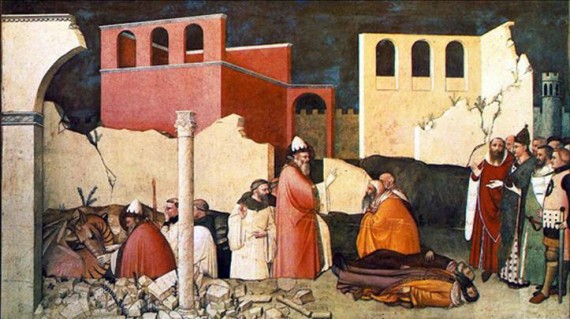Celebrating the New Year, Medieval Style
The Festival of Fools – Pieter Bruegel the Elder (1525)
Frances and Joseph Gies summed up this complicated system in their book, Life in a Medieval City
“…A traveller setting out from Venice on March 1, 1245, the first day of the Venetian year; finding himself in 1244 when he reached Florence; and after a short stay going on to Pisa, where he would enter the year 1246. Continuing westward, he would return to 1245 when he entered Provence, and upon arriving in France before Easter (April 16) he would be once more in 1244.”
This poor person appears to be more of a “time traveller” after all that confusion. So ,what did people in the Middle Ages do to ring in the New Year (whatever date that might be!)?
They Knew How to Have a Good Time: The Feast of Fools
This was a popular medieval festival that originated in France. It was celebrated on January 1st, where a mock ecclesiastical court was held, complete with a mock pope. It was a day where the tables were turned and the lower classes dressed up and poked fun at the upper classes, harking back to the Pagan Roman festival of Saturnalia, where slaves were able to to speak freely, criticize their masters without punishment, and enjoyed a feast. During the Feast of Fools, there was plenty of cross dressing, gambling, drinking, and risqué behaviour. Naturally, this didn’t sit well with the Church and after repeated pressure and regulation attempts by ecclesiastic officials, the tradition petered out in the sixteenth century.

Pope Sylvester I portrayed slaying a dragon and resurrecting its victims, a fresco by Maso di Banco (14th c.) (Wikipedia)
In England, it was customary to exchange gifts on New Year’s, since it was considered to bring good fortune for the coming year.
In Scotland and Ireland, the physical appearance of the “First Foot” (the first person to enter the house after midnight) mattered. It was said that this entrant could make or break a family’s fortunes for the rest of the year. Some people believed a light haired person would bring good luck, for others, it had to be a dark complexioned man or boy, or someone who was flat footed. Are you a red head? Sorry, but you wouldn’t have received a very warm welcome on New Year’s Eve; red heads were thought to bring bad luck and grief.
In Ireland, New Year’s Eve was known as Oíche Chinn Bliana (Year’s End Night). People banged on the walls and doors of their home to chase out the evil spirits before ringing in the New Year. Irish homes were also spotless to start the New Year off fresh. It was also a time to remember the dead; candles were lit in the windows, an empty place was set at the table, and the door was left unlocked to welcome the spirits of deceased family members who had passed on that year.
In Poland, (as well as several other Eastern European countries) New year’s Eve is known as Sylvester after St. Sylvester (†335), whose Feast Day is December 31st (and the date of his death). Legend has it that St. Sylvester imprisoned and then slew a dragon named Leviathan, who had escaped at the beginning of 1,000 AD. Leviathan’s defeat was a cause of celebration, and was called St. Sylvester’s Eve. In Poland, young boys would dress up as devils, and play pranks. One New Year’s Day, bread was baked with a ring or cross hidden inside; if the lucky recipient found a ring, it would herald marriage, if they found a cross, it could mean a life in the clergy.
Russia is one of these places where they also had a multitude of different dates for ringing in the New Year. From 1348, New Year’s was celebrated on September 1st. Prior to that, New Year’s was celebrated Match 1st, and in some places, March 22nd. It wasn’t moved officially to January 1st until 1699, by Peter The Great (1672-1725). Russians also celebrate with a New Year’s Tree, Novogodnyaya Yolka, that remains up until January 14th, when Russians celebrate a second New Year’s based on the old Julian calendar, called Old New Year’s, Staryj Novyj God. It’s a much smaller affair with family and friends, but hey, it’s a second celebration nonetheless! New Year’s is also the time that Russia’s version of Santa, Ded Moroz, Grandfather Frost, passes out gifts to children with the help of his granddaughter, Snegurochka, the Snow Maiden. Although she is a nineteenth century addition, her story has been traced back to medieval fabliaux and medieval folk tales about a “snow-child”.
However you ring out the old and ring in the new, we wish you a safe, and Happy New Year!
~Sandra Alvarez
